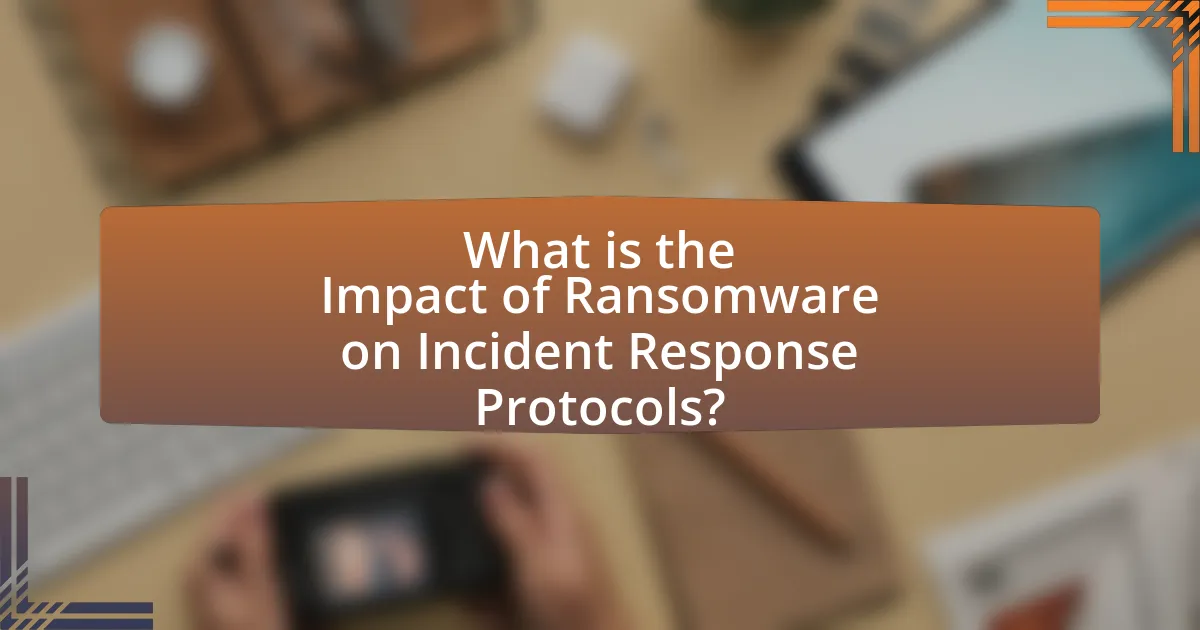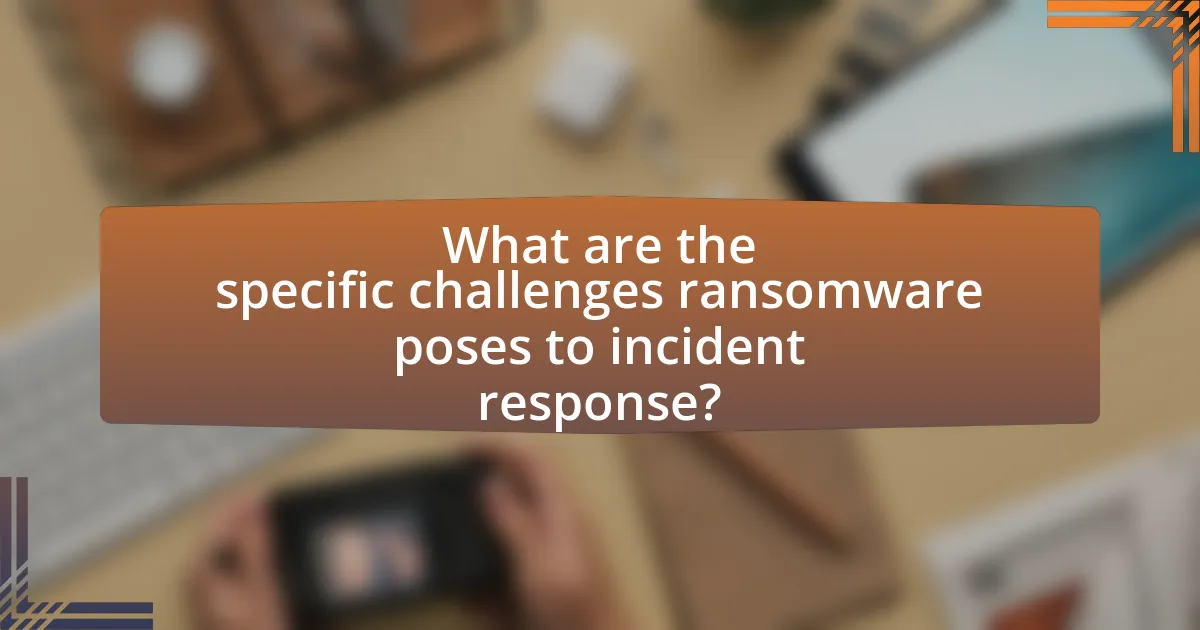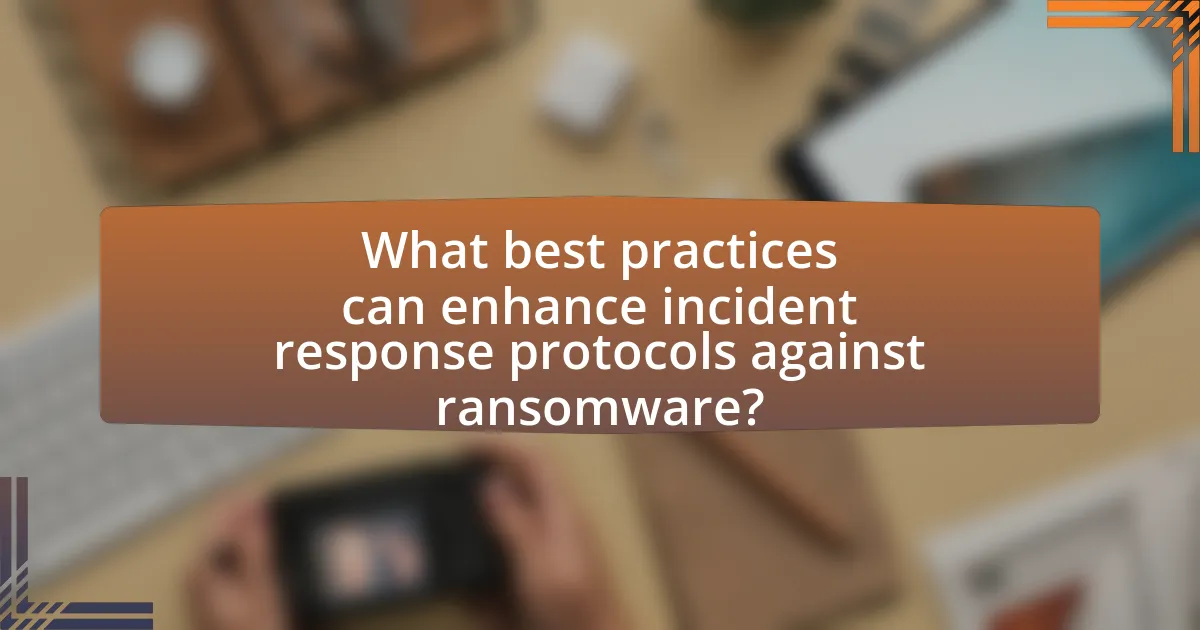The article examines the significant impact of ransomware on incident response protocols, highlighting the need for organizations to adapt their cybersecurity strategies in response to evolving threats. It discusses how ransomware complicates the incident response process by introducing challenges such as data encryption, system downtime, and ethical dilemmas regarding ransom payments. Key stages of incident response, including preparation, identification, containment, eradication, recovery, and lessons learned, are analyzed in the context of ransomware incidents. The article emphasizes the importance of understanding ransomware for effective incident response, addressing common misconceptions, and outlining best practices to enhance preparedness and resilience against such attacks.

What is the Impact of Ransomware on Incident Response Protocols?
Ransomware significantly alters incident response protocols by necessitating a more robust and adaptive approach to cybersecurity incidents. Organizations must prioritize rapid detection and containment of ransomware attacks, which often involves updating existing protocols to include specific procedures for isolating infected systems and preventing lateral movement within networks. According to the Cybersecurity and Infrastructure Security Agency (CISA), the average time to detect a ransomware attack is around 200 days, highlighting the need for enhanced monitoring and response capabilities. Furthermore, incident response teams are increasingly required to incorporate negotiation strategies for ransom payments, as well as legal considerations regarding data breaches, which complicates traditional incident response frameworks. This evolution in protocols reflects the growing sophistication of ransomware threats and the imperative for organizations to adapt their incident response strategies accordingly.
How does ransomware affect the overall incident response process?
Ransomware significantly complicates the overall incident response process by introducing unique challenges such as data encryption, system downtime, and potential data loss. When an organization is targeted by ransomware, the immediate response must prioritize containment to prevent further spread, which can delay recovery efforts. According to the Cybersecurity & Infrastructure Security Agency (CISA), organizations often face increased pressure to make quick decisions regarding ransom payments, which can lead to ethical and legal dilemmas. Additionally, the need for forensic analysis becomes critical to understand the attack vector and prevent future incidents, further straining resources. The National Institute of Standards and Technology (NIST) emphasizes that effective incident response requires a well-defined plan that includes specific protocols for ransomware incidents, highlighting the necessity for organizations to adapt their response strategies to address the complexities introduced by ransomware attacks.
What are the key stages of incident response impacted by ransomware?
The key stages of incident response impacted by ransomware include preparation, identification, containment, eradication, recovery, and lessons learned. Preparation involves establishing policies and training staff to recognize ransomware threats. Identification focuses on detecting the ransomware attack and assessing its scope. Containment aims to limit the spread of the ransomware within the network. Eradication involves removing the ransomware and any vulnerabilities exploited during the attack. Recovery is the process of restoring systems and data from backups while ensuring the ransomware is completely eliminated. Finally, lessons learned involve analyzing the incident to improve future response efforts and strengthen defenses against similar attacks. Each of these stages is crucial for effectively managing the unique challenges posed by ransomware incidents.
How does ransomware change the priorities in incident response?
Ransomware shifts the priorities in incident response by emphasizing rapid containment and recovery over traditional investigative measures. Organizations must prioritize immediate actions to isolate affected systems and prevent further spread, as ransomware attacks can escalate quickly, leading to significant data loss and operational disruption. According to the Cybersecurity and Infrastructure Security Agency (CISA), 93% of organizations that experience a ransomware attack report operational downtime, highlighting the urgency of swift response measures. This necessitates a reallocation of resources towards incident containment and restoration efforts, often at the expense of thorough forensic analysis, which may be deferred until systems are secured and business continuity is restored.
Why is understanding ransomware crucial for incident response teams?
Understanding ransomware is crucial for incident response teams because it enables them to effectively identify, contain, and mitigate ransomware attacks. Knowledge of ransomware variants, attack vectors, and encryption methods allows teams to develop tailored response strategies that minimize damage and recovery time. For instance, according to the Cybersecurity & Infrastructure Security Agency (CISA), understanding the specific behaviors of ransomware can lead to quicker identification of the attack and more effective containment measures, ultimately reducing the potential financial and operational impact on organizations.
What are the common misconceptions about ransomware and incident response?
Common misconceptions about ransomware and incident response include the belief that paying the ransom guarantees data recovery and that incident response is solely an IT issue. Paying the ransom does not ensure that the attackers will provide the decryption key or that they will not target the organization again; according to a report by Coveware, 80% of organizations that paid the ransom were attacked again. Additionally, incident response requires collaboration across various departments, including legal, communications, and management, not just IT, as highlighted by the National Institute of Standards and Technology (NIST) guidelines on incident response.
How does the evolving nature of ransomware influence incident response strategies?
The evolving nature of ransomware significantly influences incident response strategies by necessitating more adaptive and proactive measures. As ransomware attacks become increasingly sophisticated, with tactics such as double extortion and ransomware-as-a-service models, organizations must enhance their preparedness and response frameworks. For instance, the 2021 attack on Colonial Pipeline highlighted the need for rapid response capabilities and the importance of having a robust incident response plan that includes regular updates and simulations. Additionally, the rise in targeted attacks on critical infrastructure has prompted organizations to prioritize threat intelligence and collaboration with law enforcement agencies to mitigate risks effectively. These developments underscore the necessity for continuous training and investment in advanced cybersecurity technologies to stay ahead of evolving threats.

What are the specific challenges ransomware poses to incident response?
Ransomware presents significant challenges to incident response by complicating data recovery and increasing the urgency of response efforts. The encryption of critical files by ransomware restricts access to essential data, making it difficult for incident response teams to assess the full scope of the attack. Additionally, the pressure to restore operations quickly can lead to hasty decisions, potentially resulting in inadequate containment measures. According to a report by Cybersecurity Ventures, the average cost of a ransomware attack, including downtime and recovery, can exceed $1.4 million, highlighting the financial implications that can hinder effective incident response. Furthermore, the evolving tactics of ransomware attackers, such as double extortion, where data is not only encrypted but also threatened with public release, adds complexity to the negotiation and recovery processes. These factors collectively challenge the ability of organizations to respond effectively to ransomware incidents.
How does ransomware complicate detection and analysis during incidents?
Ransomware complicates detection and analysis during incidents by employing encryption techniques that obscure data and hinder forensic investigations. The encryption process renders files inaccessible, making it difficult for security teams to identify the scope of the attack and the specific vulnerabilities exploited. Additionally, ransomware often includes mechanisms to delete backups and logs, further impeding the ability to trace the attack’s origin and timeline. According to a report by Cybersecurity Ventures, the average time to detect a ransomware attack can exceed 200 days, illustrating the significant delays in response and analysis caused by these tactics.
What tools are most effective for detecting ransomware attacks?
The most effective tools for detecting ransomware attacks include advanced endpoint detection and response (EDR) solutions, network traffic analysis tools, and behavior-based anomaly detection systems. EDR solutions, such as CrowdStrike and SentinelOne, utilize machine learning algorithms to identify suspicious activities and potential ransomware signatures in real-time. Network traffic analysis tools, like Darktrace, monitor data flows for unusual patterns that may indicate a ransomware infection. Behavior-based anomaly detection systems, such as Microsoft Defender for Endpoint, analyze user and system behaviors to flag deviations that could suggest ransomware activity. These tools are validated by their widespread use in cybersecurity frameworks and their ability to reduce response times to ransomware incidents significantly.
How can incident response teams improve their analysis of ransomware incidents?
Incident response teams can improve their analysis of ransomware incidents by implementing a structured framework for threat intelligence sharing and enhancing their forensic capabilities. A structured framework allows teams to systematically gather, analyze, and share information about ransomware variants, attack vectors, and indicators of compromise, which can lead to quicker identification and mitigation of threats. Enhancing forensic capabilities involves investing in advanced tools and training that enable teams to conduct thorough investigations, uncovering the methods used by attackers and the extent of the damage. According to the 2021 Verizon Data Breach Investigations Report, organizations that utilize threat intelligence are 50% more likely to detect breaches faster, underscoring the importance of these improvements in incident response analysis.
What are the implications of ransomware on communication during incidents?
Ransomware significantly disrupts communication during incidents by creating barriers to information flow and decision-making. When organizations are targeted, the immediate focus shifts to containment and recovery, often leading to a breakdown in internal and external communication channels. This disruption can result in misinformation, delayed responses, and a lack of coordination among stakeholders. For instance, a study by the Cybersecurity and Infrastructure Security Agency (CISA) highlights that effective communication is critical during a ransomware attack, as it helps manage public perception and ensures that all parties are informed about the incident’s status. Furthermore, the urgency to respond can lead to hasty decisions, which may not be communicated effectively, exacerbating the situation.
How should incident response teams communicate with stakeholders during a ransomware attack?
Incident response teams should communicate with stakeholders during a ransomware attack through clear, timely, and transparent updates. This approach ensures that stakeholders are informed about the situation, the steps being taken to mitigate the attack, and any potential impacts on operations. Regular updates, ideally every few hours, help maintain trust and manage expectations, as evidenced by the 2021 Cybersecurity and Infrastructure Security Agency (CISA) guidelines, which emphasize the importance of communication in crisis management. Additionally, using multiple communication channels, such as emails, conference calls, and secure messaging platforms, can enhance the effectiveness of the communication strategy.
What role does public relations play in managing ransomware incidents?
Public relations plays a critical role in managing ransomware incidents by facilitating effective communication between the organization and its stakeholders. During a ransomware attack, public relations teams are responsible for crafting clear, transparent messages that inform employees, customers, and the media about the situation, the steps being taken to resolve it, and the potential impact on affected parties.
For instance, a study by the Ponemon Institute found that organizations with proactive communication strategies during cyber incidents experience a 20% reduction in reputational damage compared to those without such strategies. This highlights the importance of timely and accurate information dissemination in maintaining trust and credibility. Additionally, public relations efforts can help mitigate misinformation and rumors that may arise during a crisis, further stabilizing the organization’s reputation.

What best practices can enhance incident response protocols against ransomware?
Implementing a multi-layered security approach enhances incident response protocols against ransomware. This includes regular software updates, which address vulnerabilities that ransomware exploits; employee training to recognize phishing attempts, a common ransomware delivery method; and maintaining robust data backups to ensure recovery without paying ransoms. According to the Cybersecurity and Infrastructure Security Agency (CISA), organizations that conduct regular security assessments and implement incident response plans can significantly reduce the impact of ransomware attacks. Additionally, the 2021 Verizon Data Breach Investigations Report indicates that 85% of breaches involve a human element, underscoring the importance of training and awareness in preventing ransomware incidents.
How can organizations prepare their incident response teams for ransomware threats?
Organizations can prepare their incident response teams for ransomware threats by implementing comprehensive training programs focused on ransomware detection, containment, and recovery strategies. These training programs should include simulations of ransomware attacks, which have been shown to enhance team readiness and response effectiveness. According to a report by Cybersecurity & Infrastructure Security Agency (CISA), organizations that conduct regular tabletop exercises can improve their incident response capabilities by up to 50%. Additionally, maintaining up-to-date incident response plans that specifically address ransomware scenarios is crucial, as it ensures that teams are familiar with the latest tactics used by attackers. Regular updates and reviews of these plans, informed by threat intelligence, further strengthen an organization’s resilience against ransomware threats.
What training and resources are essential for effective ransomware response?
Effective ransomware response requires specialized training in incident response, cybersecurity protocols, and threat intelligence, alongside resources such as up-to-date software tools, incident response plans, and access to cybersecurity experts. Training programs should include simulations of ransomware attacks to prepare teams for real-world scenarios, as evidenced by studies showing that organizations with regular training exercises experience 50% fewer successful attacks. Additionally, resources like threat intelligence feeds provide critical information on emerging ransomware variants, enabling proactive defenses. Access to cybersecurity frameworks, such as the NIST Cybersecurity Framework, further enhances an organization’s ability to respond effectively to ransomware incidents.
How can simulations and drills improve readiness for ransomware incidents?
Simulations and drills enhance readiness for ransomware incidents by providing organizations with practical experience in responding to such attacks. These exercises allow teams to practice their incident response plans in a controlled environment, identifying gaps and weaknesses in their protocols. For instance, a study by the Ponemon Institute found that organizations that conduct regular incident response exercises reduce their average breach costs by 30%. This demonstrates that through simulations, teams can refine their skills, improve communication, and ensure that all members understand their roles during an actual ransomware event.
What are the key components of a ransomware-specific incident response plan?
The key components of a ransomware-specific incident response plan include preparation, identification, containment, eradication, recovery, and lessons learned. Preparation involves establishing a response team and developing communication protocols. Identification focuses on detecting ransomware attacks through monitoring and alerts. Containment aims to limit the spread of the ransomware by isolating affected systems. Eradication involves removing the ransomware and any vulnerabilities that allowed the attack. Recovery includes restoring data from backups and ensuring systems are secure before resuming operations. Finally, lessons learned emphasize analyzing the incident to improve future response efforts. These components are essential for effectively managing ransomware incidents and minimizing their impact on organizations.
What should be included in the incident response plan to address ransomware?
An incident response plan to address ransomware should include preparation, detection, containment, eradication, recovery, and lessons learned. Preparation involves establishing a response team and conducting regular training and simulations. Detection requires implementing monitoring tools to identify ransomware activity quickly. Containment focuses on isolating affected systems to prevent further spread. Eradication entails removing the ransomware and any vulnerabilities exploited. Recovery involves restoring data from backups and ensuring systems are secure before bringing them back online. Finally, lessons learned should be documented to improve future responses. These components are essential for effectively managing ransomware incidents and minimizing their impact on organizations.
How can organizations ensure their incident response plan remains up-to-date with ransomware trends?
Organizations can ensure their incident response plan remains up-to-date with ransomware trends by regularly reviewing and updating their protocols based on the latest threat intelligence and industry best practices. This involves subscribing to cybersecurity threat intelligence feeds, participating in information-sharing organizations, and conducting regular training sessions for staff to recognize and respond to emerging ransomware tactics. For instance, the Cybersecurity and Infrastructure Security Agency (CISA) provides resources and updates on ransomware trends, which organizations can leverage to adapt their response strategies effectively. Additionally, conducting tabletop exercises that simulate ransomware attacks can help organizations test and refine their incident response plans in real-time scenarios, ensuring they remain relevant and effective against evolving threats.
What practical steps can organizations take to mitigate ransomware risks?
Organizations can mitigate ransomware risks by implementing a multi-layered cybersecurity strategy that includes regular data backups, employee training, and robust security measures. Regularly backing up data ensures that organizations can restore their systems without paying ransoms, as 60% of companies that experience a ransomware attack and do not have backups end up paying the ransom. Employee training on recognizing phishing attempts and safe internet practices reduces the likelihood of successful attacks, as human error is a significant factor in ransomware incidents. Additionally, employing advanced security measures such as firewalls, intrusion detection systems, and endpoint protection can help detect and prevent ransomware attacks before they infiltrate the network. According to the Cybersecurity and Infrastructure Security Agency (CISA), organizations that adopt these practices significantly lower their risk of falling victim to ransomware.
How can regular backups and updates reduce the impact of ransomware?
Regular backups and updates significantly reduce the impact of ransomware by ensuring that data can be restored and vulnerabilities are patched. Backups allow organizations to recover their systems to a point before the ransomware attack, minimizing data loss and operational downtime. For instance, a study by Cybersecurity Ventures indicates that businesses with regular backup protocols can recover from ransomware incidents in less than 24 hours, compared to those without, which may face weeks of disruption. Updates, on the other hand, address security vulnerabilities that ransomware exploits, thereby decreasing the likelihood of an attack. According to the Cybersecurity and Infrastructure Security Agency (CISA), timely software updates can prevent up to 85% of known vulnerabilities from being exploited. Thus, implementing regular backups and updates is a critical strategy in mitigating the effects of ransomware.
What role does employee training play in preventing ransomware incidents?
Employee training plays a critical role in preventing ransomware incidents by equipping staff with the knowledge to recognize and respond to potential threats. Effective training programs teach employees about phishing tactics, safe browsing practices, and the importance of strong passwords, which are essential in mitigating the risk of ransomware attacks. According to a report by the Cybersecurity and Infrastructure Security Agency (CISA), organizations that implement regular cybersecurity training for employees can reduce the likelihood of successful phishing attacks by up to 70%. This statistic underscores the importance of training as a proactive measure in enhancing an organization’s overall security posture against ransomware threats.
